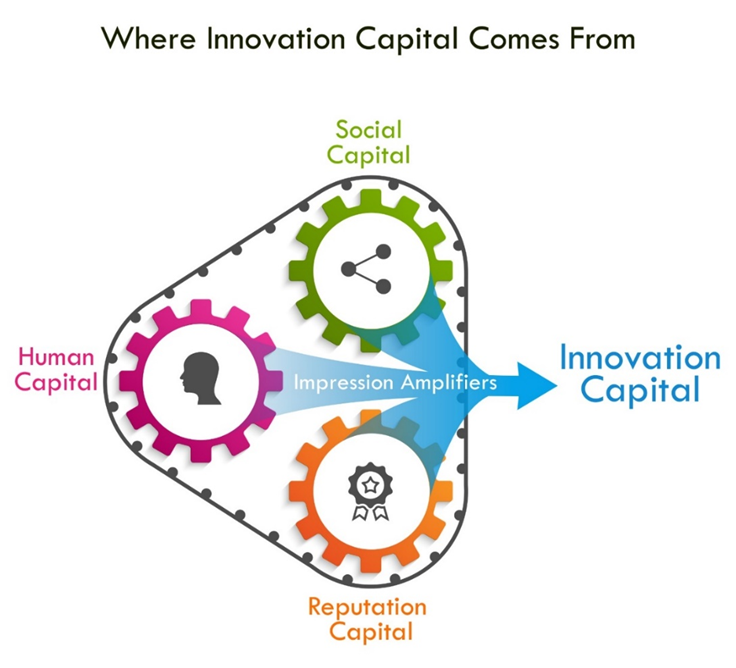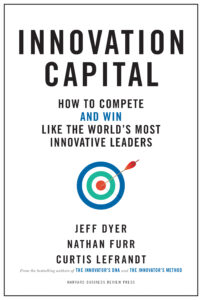Reprinted from Forbes.com eff Dyer, Nathan Furr and Mike HendronContributor Leadership Strategy
What are the components of innovation capital?
One’s innovation capital—or ability to convince sponsors to support a novel idea—comes from three interrelated innovation-specific factors:
Human capital: who you are as a leader of innovation
Social capital: who you know with key expertise and resources
Reputation capital: what you’ve done to warrant a reputation for innovation
In addition, these three types of capital can be multiplied by impression amplifiers—visible actions you take that help you gain attention and credibility for your ideas
How exactly are potential supporters influenced by these factors? In academia, we use what we call a simultaneous equation model to describe how these factors work together.[4] Sponsors are simultaneously weighing all these factors: whether you have the innovation skills as a leader to pull this off (who you are as a leader of innovation), whether you are well connected with others who will need to support your project (who you know with resources or expertise), and whether you have a track record and reputation for innovation success (what you are known for). Finally, potential sponsors look at the things you have done to persuade them (the impression amplifiers). They consider all these elements of your innovation capital to decide whether to support you and your ideas.
How to Build Reputation Capital
What are some ways to build a favorable reputation for innovation?
Jeff Bezos, Elon Musk, and Mark Zuckerberg all sit atop our most innovative leaders list. Why? Because they were founders. More importantly, they were founders of successful companies doing something innovative and impactful. The most valuable thing you can do to build your reputation for innovation is to be a founder. Let us give you our definition of what it means to be a founder: Playing a central role in starting and managing an initiative that will have impact (preferably visible and large) on an organization or the broader world.
There are many ways to be a founder. In fact, about half of all new ventures created are actually created by hybrid entrepreneurs—individuals who keep their day jobs and start a venture on the side.[5] There are also many opportunities to create a new venture—launching a new product, service, or business—inside a company as a corporate entrepreneur (or intrapreneur). Being a corporate entrepreneur has a profound effect on both your reputation for innovation and your prospects for leadership opportunities. We know this because we studied 600 business professionals working for established companies over a 5-10 year time period and found that those who were corporate entrepreneurs were promoted faster and were paid more money than their colleagues who did not.[6] Being a corporate entrepreneur gets you noticed! But you don’t have to found a new business to get noticed. You can be the founder of a new process to improve customer service, a more effective way to attract top human capital, a company-sponsored conference or any number of initiatives that bring value to your organization.
Being a founder has a profound impact on your career because it provides a relevant, observable, and hard to imitate signal (the three characteristics of strong reputation signals) of your leadership capabilities. Being the founder of an innovative product or service requires holistic thinking, taking into account all aspects of what makes a new venture successful—from its value proposition to the customer (user), product development, technologies, cost to deliver, performance metrics and finally to getting the resources needed for implementation. What better way to signal that you have leadership capabilities? Moreover, it’s hard. “I think the most important thing that I look for [when funding a project] is really, who’s that champion?” says Adobe CEO Shantanyu Narayen (#7 on our list). “I think ideas come from everywhere. But I think all of the great products we’ve developed as being characterized by somebody who is incredibly passionate about that idea….Championing change is hard.” In sum, being a founder sends a powerful reputation signal of your abilities as a leader.“You need to have a combination of stubbornness and flexibility. Even though those two things seem at odds with one another, I don’t think they are. Because you can be stubborn on your vision but flexible on the details of how you get there.” -Jeff Bezos


What did you find most surprising in your research of innovation leaders?
I think we were surprised at the number of different ways that leaders built their innovation capital.
- Some founded innovative companies (e.g., Jeff Bezos, Elon Musk, Mark Zuckerberg) and built their innovation capital rather quickly as their new venture proved disruptive to incumbents and competitors. Others built their innovation capital rather slowly as they navigated their way through a large company with multiple small wins (e.g., Satya Nadella, Indra Nooyi, Mark Parker). Those who had to navigate their way through large firms seemed to excel at emotional intelligence—the ability to read others’ emotions and respond appropriately. Those who founded companies and stayed at the top were more likely to lead with more brutal intellectual honesty (e.g., Steve Jobs; Elon Musk).
- Some built their innovation capital largely through building relationships and social capital. Marc Benioff launched Dreamforce, now the largest software trade show in the world with more than 150,000 attendees, which was a critical action to build his social capital and innovation capital. We tell the story of David Bradford, current CEO of FluentWorlds and former CEO of Fusion-IO and HireVue, and how his innovation capital was largely built through relationships—spending 1-2 hours per day networking over the past 30 years.
- Some leaders, like Jeff Bezos, succeed primarily by being a “customer first” innovator. Bezos has established an innovation process at Amazon called “working backwards” which starts with an obsessive focus on a customer’s needs and then works backwards to figure out how to best meet those needs. In contrast, Musk cares about customer needs as well but only at a high level; he picks what he perceives as big important needs that haven’t been met because of technology constraints and is more of a “technology first” innovator. He attributes his problem solving success to first-principles thinking—the practice of identifying the fundamental key constraints to achieving a breakthrough in performance, and then testing every option possible for eliminating one or more of those constraints. Bezos’ approach works especially well when the innovation requires overcoming a lot of market/demand uncertainty (will people buy it?) and Musk’s approach works well when there is a lot of technological uncertainty (can we build it?).
“I think it’s very helpful to cross-fertilize ideas from different industries.” -Elon Musk


